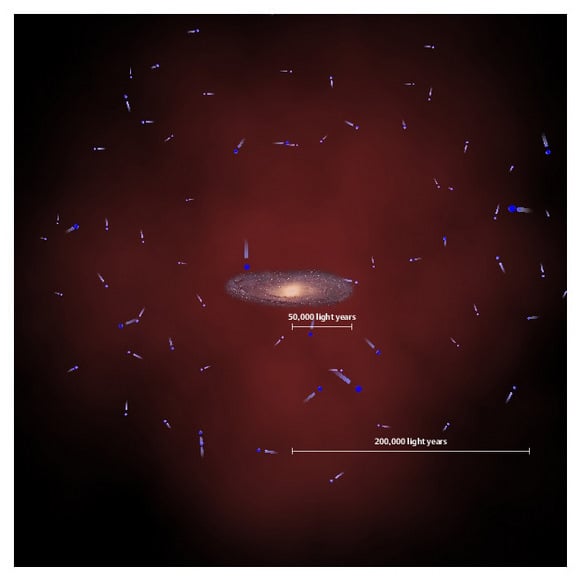[/caption]
The mass of the Milky Way depends on what you consider this question to mean. If you are only talking about the visible part of the Milky Way - all the stars, gas and dust that make up the disk - then the Milky Way's mass is between 200-600 billion times that of the Sun. We can't just put the Milky way on a bathroom scale to get this number, however. This number is reached by counting the
number of stars in the galaxy
and assuming their mass is roughly that of the Sun. The mass varies depending on where one defines the edge of the Milky Way to be.
But there is another way to check the heft of the Milky Way - by measuring how fast stars are rotating around the disk, the mass of the disk itself can be determined. In other words, the heavier the Milky Way is, the more of an effect gravity will have on the rotation, and the faster the stars will move through the disk. This number comes up to be a whopping 1-2
trillion
times the mass of the Sun! The
most recent estimate
from a study using information from the
Sloan Digital Sky Survey
measuring the velocity of over 2,4oo stars put the mass of the Milky Way and its halo at 1 trillion solar masses. Though astronomers don't use kilograms when measuring such large objects as the Sun or galaxies, the Milky Way and its halo would be about 6 x 10^42 kilograms.
Where is all of this matter, if not in the stars? As with many contemporary mysteries in astronomy, the answer is
dark matter
. The Milky Way is thought to be home to a halo of dark matter - matter that cannot be detected except through its gravitational influence - which makes up approximately 80-90% of its mass. That's right, the mass of the Milky Way that can be seen (through visible, X-ray, infrared, etc.) makes up only about 10-20% of its mass. This halo may extend out to as far as 300,000 light years from the galactic center.
For more information about the Milky Way, you can refer to
Episode 99 of Astronomy Cast
, visit the rest of our section here in the
Guide to Space
, or
Swinburne Astronomy Online
.
Source:
Sloan Digital Sky Survey
 Universe Today
Universe Today
